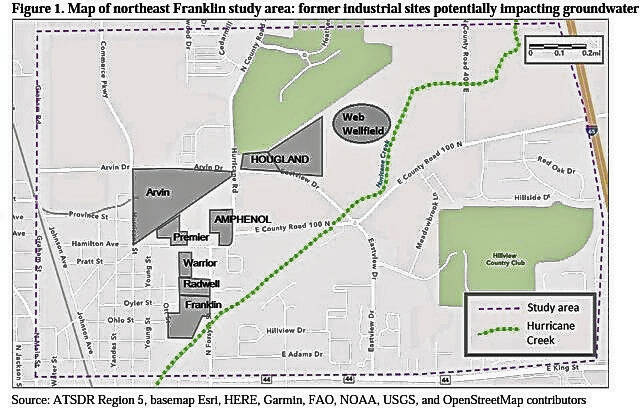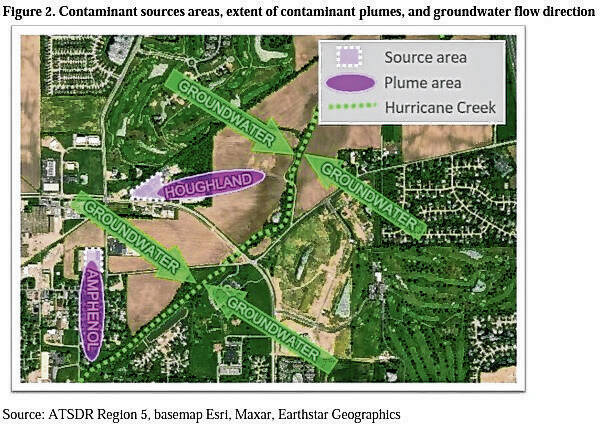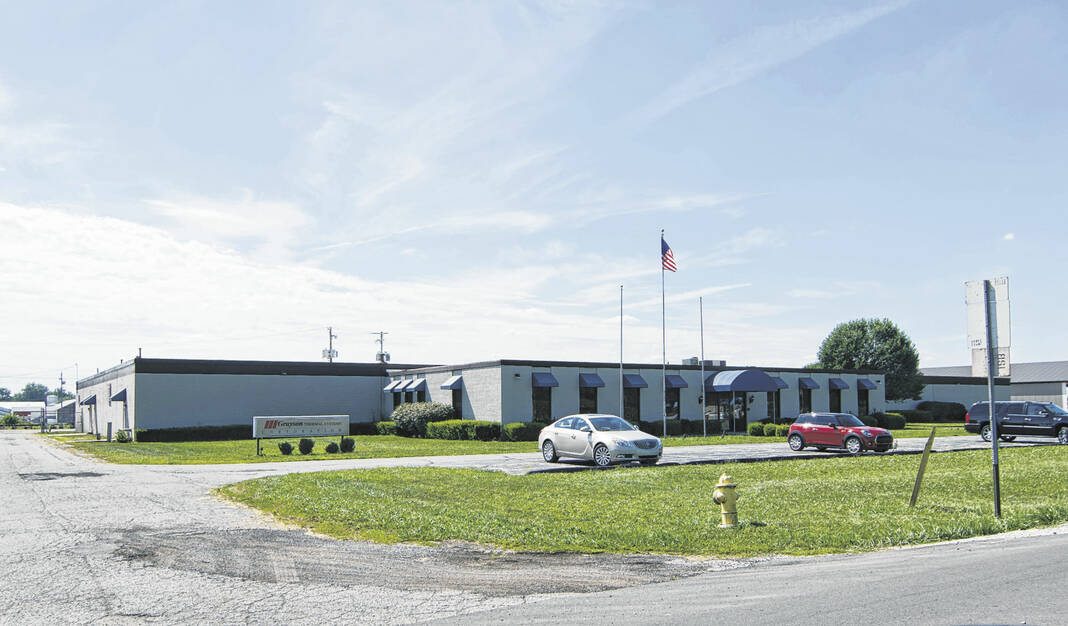After years of fear of what’s in the ground, in the water and in the air around Amphenol and the former Hoagland Cannery, Franklin can breathe easy.
A Health and Hazard Assessment report from the U.S. Department of Health and Human Services Agency for Toxic Substances and Disease Registry, or ATSDR, has analyzed all samples gathered from the site and determined that there was never enough contamination in any home or business to cause cancer. Additionally, only two homes and one business had any level of contamination that could be traced to Amphenol or nearby sites. For the sites that did have contamination, it was at a level that would only be harmful to a fetus if a pregnant woman was exposed to the toxin.
For the past six years, the Franklin community has been on edge after the idea was popularized that contamination at Amphenol and other area industrial sites might have caused cancer among children who live in the nearby neighborhood. This report puts that idea to rest with scientific testing and analysis. Since cancer has no known cause, it may never be known what sickened the children.
The history
Since the beginning, city officials had been told by the U.S. Environmental Protection Agency and Indiana Department of Environmental Management that it was unlikely the industrial sites had caused the illnesses. A group of parents known as If It Was Your Child came forward and together with the mayor’s office, they asked the EPA to dig deeper and provide evidence the contamination was not the root cause, said Mayor Steve Barnett.
The contamination accumulated at the site over 22 years, when Bendix operated at the site, 980 Hurricane Rd., from 1961 to 1983. During that period, chemicals from plating operations at the site were routed into a sanitary sewer manhole and discharged into the municipal sanitary sewer system. In addition, spills on-site migrated to the soil beneath the building through cracks in the foundation.
This caused volatile organic compounds, or VOC, including trichloroethylene, or TCE, and tetrachloroethylene, or PCE, to seep into the soil and groundwater. These chemicals are known carcinogens, but only at a much higher concentration than was found at the site and nearby properties, the report says.
The contamination was first known to be an issue in 1984, after Bendix was purchased by Amphenol/Franklin Power Products, however no action was taken to clean it up at the time. Two cleanup orders have been initiated at the site since 1990, with the first resulting in a pump and treat system that is still in place at the site but will be decommissioned as part of the final clean-up plan.
In 2018 the 1998 order was reissued after it was revealed there could be additional contamination that was not cleaned up in the previous orders. At the time, people began to speak up about pediatric cancer, which fueled the efforts to ensure the site is fully remediated.
The order has resulted in further investigation at the site and extensive testing of groundwater and air at the site and within the plume of contamination, or area that the EPA believes the contamination has spread based on extensive testing and computer modeling.
The final clean-up plan has been issued, and the report on health impacts from ATSDR gives a resolution to questions on health impacts or the VOCs.
Air contamination remedied
The 75-page analysis considered all samples taken by the EPA and IDEM at Amphenol, the former Hoagland Cannery, the Webb Wellfield and adjacent sites including homes, businesses and schools.
One nearby non-residential property, the Johnson County Recycling Center, in the past, had airborne contamination at a level that could have caused fetal heart abnormalities if one of the employees had been pregnant. The airborne contamination is believed to have seeped up through the foundation because of contaminated groundwater, the report says.
Samples taken at the recycling center after the county improved ventilation, show the measure has lowered the levels of VOCs. There are no further health concerns at the recycling center, the report says.
Of the 37 nearby homes where samples were gathered, two had VOC levels that could harm human health, the report says. However, the level would only be enough to cause fetal heart abnormalities if a resident had been pregnant. The level of VOCs would not cause cancer, the report notes.
One home had indoor air contamination from 1-2 DCA, a chemical unrelated to Amphenol that likely stemmed from a household cleaner. The EPA advised the homeowner to get rid of the cleaner. Subsequent samples after its removal show the air quality improved, the report says.
Remediation measures have been taken at the two impacted homes and others that did not have a potentially harmful level of VOCs. The EPA installed sub-slab depressurization systems, or SSDS, at seven homes, performed plumbing repairs at 11 homes, and replaced or re-lined 2,600 feet of damaged sewer pipe along Forsythe Street, the report says.
The EPA has also followed up with indoor air testing after the repairs were completed and the air quality had improved. ATSDR does not believe indoor air poses an ongoing threat to nearby residents, the report says.
At Webb and Needham elementary schools, air samples did not show a level of VOCs that would be hazardous, though groundwater under the school showed evidence of contamination stemming from the Hoagland Cannery. Soil samples were slightly elevated but not at a harmful level, the report shows.
Though the indoor level was not elevated, Franklin Community Schools installed SSDS in the summer of 2019 as a precaution, the report says.
Contamination at a level that would be harmful to human health was not found at other nearby non-residential buildings including the former gymnastics center, the report says.
No water contamination
The report also says drinking water in Franklin is not now, nor has it ever been contaminated with dangerous levels of VOCs. Though the chemicals were detected in water from the Webb Wellfield in 1988, Indiana American Water took steps to mitigate that by blending the water with water from other wells before it was distributed to homes in Franklin, the report says following an analysis of historic water quality reports.
Water used in Franklin homes has never exceeded the EPA’s standards for TCE and PCE and has always been safe to drink, the report says.
Contamination at the Webb Wellfield stemmed from the Hoagland Cannery, which IDEM is remediating. All wells that were contaminated by groundwater were taken offline in 2013 and the community’s water has since been sourced from wells that are not located in the contaminated area, the report says.
The three wells where Franklin’s water is sourced are located 0.75 miles, seven miles and 12 miles away from the Webb Wellfield, the report says.
The water in Hurricane Creek contained no measurable level of VOCs when it was tested in 2018. However, the report notes the water could have had measurable levels of VOCs in the past when the companies were actively discharging chemicals.
The future
Barnett, his chief of staff Tara Payne, and consulting firm Enviroforensics have been working with the EPA for the last six years to make sure the site is cleaned up appropriately. This report is proof those efforts have paid off, Barnett said.
“I am very satisfied with their (the EPA’s) response and their efforts early on, to get out there and … (be) persistent about testing and make sure we get through this,” Barnett said.
Franklin officials now hope to reverse the bad reputation the city gained from widespread reports from Indianapolis media that led people to believe Franklin is unsafe.
Many got the false impression that contamination had been spread all over the city through the sewers. However, the contamination was contained within a small radius of Amphenol and Hoagland, representing just 2.4 square miles of the city. Contamination only infiltrated the sewers within the groundwater plumes around the sites, the report says.
People also feared the water supply was tainted, but the report’s analysis showed water never was contaminated.
Barnett hopes those fears can be definitively erased with this report, he said.
“I’m feeling good about the hard work that our administration has put into this; that it’s finally coming to light that our hard work is paying off for the citizens,” Barnett said. “Frankly (I hope this) eases their minds — ease everybody’s minds that we can safely live here and drink the water.”
Though Amphenol and Hoagland are well on the way to being fully remediated, the mayor’s office still gets calls asking if it is safe to move to Franklin or open a business there. Some weeks there are one or two calls, and though the volume is reduced from the height of media reports, it is frustrating people still see Franklin as an unsafe place to live, Barnett said.
The cleanup at the site is in its final stages, and work is expected to begin soon on the several years-long process to remove the pollutants from the ground directly on the Amphenol site.
“It’s going to take a couple more years to get to that finish line. And we’re headed in that direction,” Barnett said. “Everybody is safe, but we’re still going to clean that what’s left.”
Barnett said he hopes Indianapolis media outlets will set the record straight on contamination in Franklin.
If It Was Your Child did not return requests for comment.
READ THE FULL REPORT BELOW:









